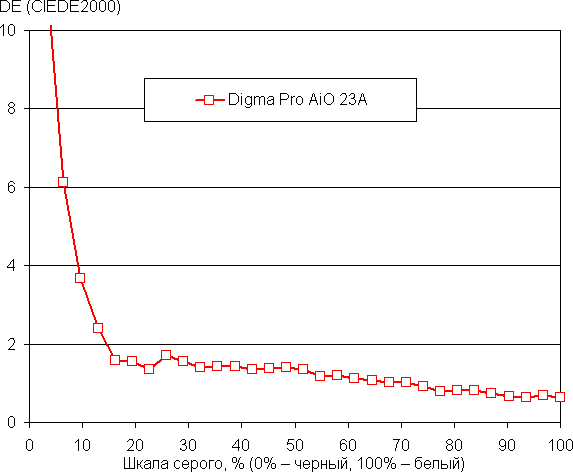We took a detailed look at the Digma Pro monoblock with a 27-inch display running on eleventh generation Intel Core processors. Today we are reviewing a model with a 24-inch screen, equipped with AMD Ryzen 5000 series processors. Both lines of monoblocks have much in common, primarily related to the design approach. They are based on a universal “monoblock” chassis, where a standard Thin Mini-ITX board with a soldered processor is installed. However, the choice of processors is limited to this chassis, and here we see a transition from the use of tenth generation Intel Core to the introduction of eleventh generation Intel Core and AMD Ryzen 5000.
This approach has its pros and cons. The disadvantage is that the manufacturer is limited to a specific chassis, which may become outdated relative to the new computer platform. However, this also ensures high maintainability and upgradeability. An important advantage for manufacturers is the rapid launch into production of monoblocks with a wide range.
For some time, Digma Pro monoblocks predominantly used tenth generation Intel Core processors. However, with the advent of more affordable eleventh-generation Intel Core and AMD Ryzen 5000, the company began to actively implement them in its devices. Compared to 11th-generation Intel Core in terms of performance and cost, AMD processors offer a slight edge, making them an attractive choice for budget all-in-one PCs. Our review focuses on an all-in-one PC with the AMD Ryzen 5 5625U processor, which, despite its recent release, turns out to be comparable to previous models such as the Ryzen 5 5600U and Ryzen 5 7530U.
Thus, Digma Pro aims to provide a wide range of all-in-one PCs to suit different needs, and the move from Intel to AMD opens up new opportunities to optimize performance and cost in this segment.
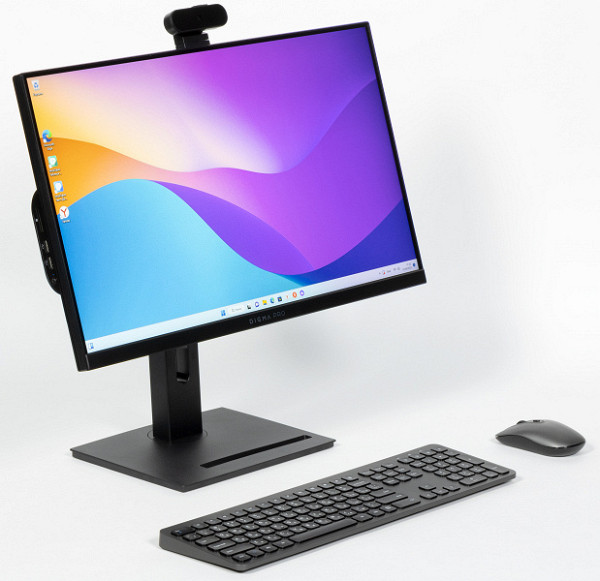
As a result, Digma Pro AiO 23A monoblocks successfully complemented the Digma Pro AiO 23i line, which was limited to the “tenth” generation Core i processors. The new Digma Pro AiO 23A model has made a transition to more current processors, offering a choice between Core i5-10210U and Ryzen 3 5425U, as well as between Core i7-10610U and Ryzen 5 5625U. At the moment, there are no alternatives to the Core i3-10110U in the AMD line, which makes all-in-one PCs with AMD Ryzen the most affordable in this segment.
However, there is additional choice for consumers with the introduction of Digma Pro AiO 23A. Comparing the Core i5-10210U and Ryzen 3 5425U, as well as the Core i7-10610U and Ryzen 5 5625U at the same price, you can see some symbolic differences, although Ryzen all-in-one PCs are priced slightly higher. However, they are of more interest to buyers given the benefits that Ryzen processors can offer. Thus, the Digma Pro AiO 23A based on Ryzen 5 5625U becomes a more attractive option for those looking for high performance and modern technologies in an all-in-one PC.
Exterior and scope of delivery
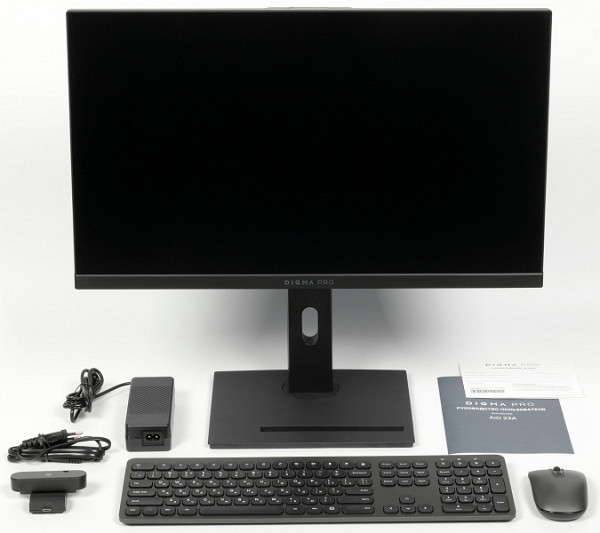
It is almost impossible to come up with radically new concepts for inexpensive all-in-one PCs, especially taking into account small screen diagonals such as 24" (formally 23.8"). In this segment, Full HD resolution remains the most popular, since matrices with a higher resolution or larger diagonal are more expensive. Thus, the combination of 24" and Full HD remains the most popular not only among monoblocks, but also among individual monitors.
However, Digma Pro AiO 23A stands out as a complete package, including a mouse and keyboard. The manufacturer also preinstalled the operating system, ensuring readiness for use immediately after switching on. It is important to note that you can later replace the supplied peripherals, since both the mouse and keyboard are wireless, but at the same time quite simple. This choice makes only a small change to the overall cost of the kit, while still allowing for future upgrades. A similar set was used in 27-inch monoblocks from the same company.

The webcam is also included separately — it is difficult to integrate them into modern frameless models. Retractable modules “rescue”, but in Digma Pro AiO 23A the approach is a little simpler and in some ways better: just a USB connector on the camera module itself...
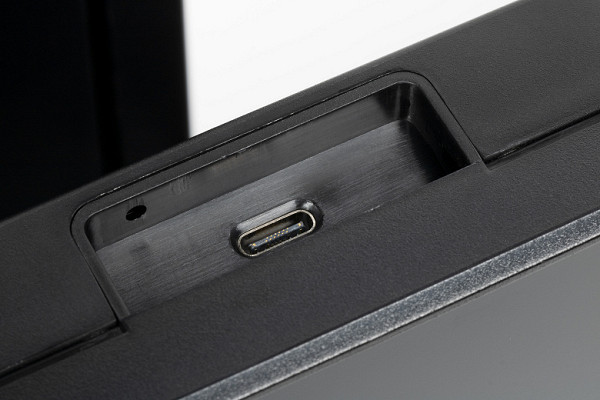
...and in a niche on the top edge of the candy bar. Accordingly, if the camera is not needed, you can not connect it at all, and use the connector for other purposes: this is an absolutely standard USB 2.0 Type-C. Of course, you can connect the camera only when necessary. Well, if you need it often, then it’s easier to leave it permanently, since the standard camera has a shutter.
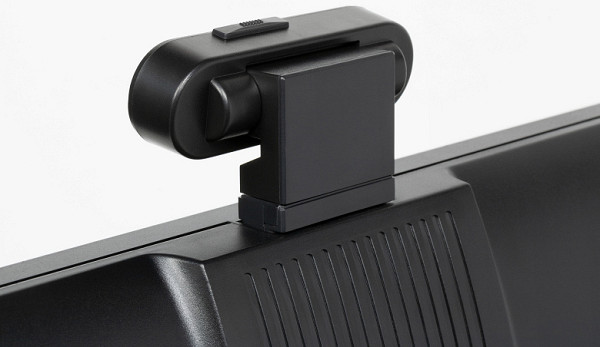
There is no need to talk about this model in more detail: it is a typical budget VGA model with a stated resolution of 2 MP (using software interpolation). However, the detachable design seems to be preferable as it covers the basic needs and the user can optionally purchase an upgraded device if required. In addition, a connector for such a device is already provided.
The stand here, unlike the top model Digma Pro AiO 27i, is not economical. In this model, you can adjust not only the tilt, but also the height of the “monitor”, and also rotate it 90 degrees into portrait mode. The presence of a VESA mount with a pitch of 75 mm also allows you to do without a standard stand.
The right side (from the point of view of the user sitting at the table) hints at the age of the chassis, presumably created before the release of Ryzen 5 processors and during the period of relevance of optical drives. Therefore, the presence of a card reader for SD cards and a pair of USB ports on the left side, connected to a USB 2.0 hub, is perceived without surprise.
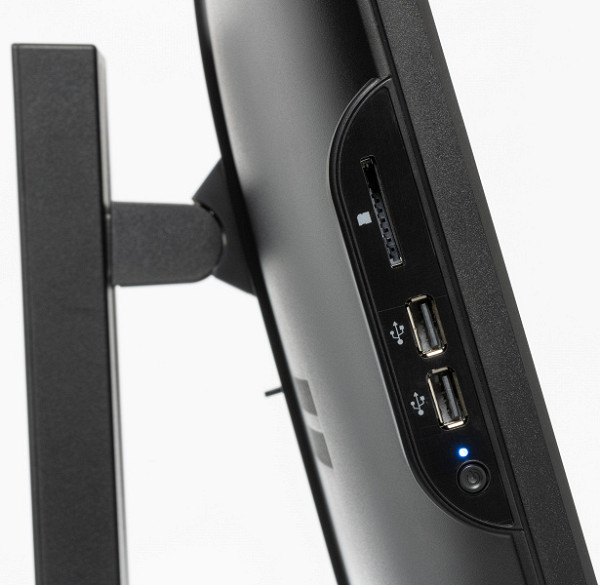
On the other hand, we as consumers may feel spoiled. However, in practice, 40 MB/s read and write speeds for the cards are still better than not having this option, and it's not that bad compared to the potential hundreds of megabytes per second. In addition, widely used flash drives are still subject to technological limitations that were relevant 20 years ago. Additionally, it is worth considering that for copying small volumes of documents in the office, data transfer speed is not a critical factor. However, modern platforms provide many fast USB ports, and perhaps it is time to reconsider this outdated approach, which seems increasingly strange against the backdrop of modern technology.
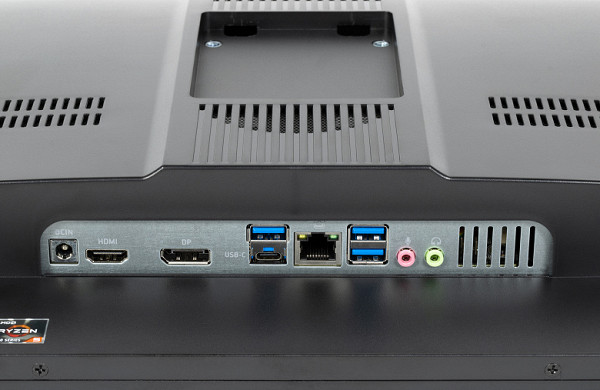
Basic communication capabilities are provided by connectors built into the motherboard. These include four USB 3.0 ports (formally USB 3.1 Gen1), including a fashionable Type-C connector. A headphone jack, microphone input, gigabit wired network and wireless adapter are also available. Additionally, two video outputs are provided that meet current standards. This allows you, for example, to connect an additional 4K monitor and transfer the signal to a 4K TV using a long cable. While such features may be overkill in offices, they can be useful for home use. Recently, consumers are increasingly considering all-in-one PCs instead of laptops with similar characteristics, especially if battery life is not required. Manufacturers take this trend into account by providing a wide selection of all-in-one PCs to suit the needs of different users.
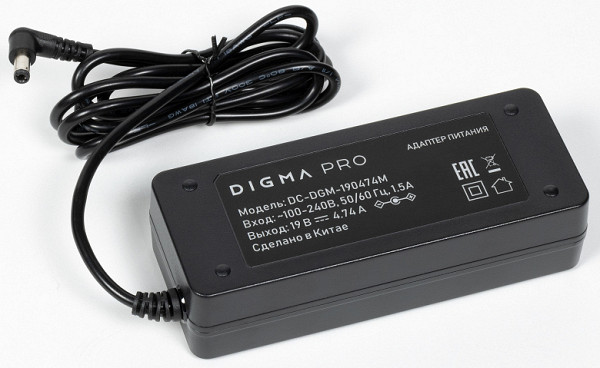
Basic communication capabilities are provided by connectors built into the motherboard. These include four USB 3.0 ports (formally USB 3.1 Gen1), including a fashionable Type-C connector. A headphone jack, microphone input, gigabit wired network and wireless adapter are also available. Additionally, two video outputs are provided that meet current standards. This allows you, for example, to connect an additional 4K monitor and transfer the signal to a 4K TV using a long cable. While such features may be overkill in offices, they can be useful for home use. Recently, consumers are increasingly considering all-in-one PCs instead of laptops with similar characteristics, especially if battery life is not required. Manufacturers take this trend into account by providing a wide selection of all-in-one PCs to suit the needs of different users.
Hardware configuration
| Digma Pro AiO 23A DM23R5 | |
|---|---|
| CPU | AMD Ryzen 5 5625U |
| RAM | 2×DDR4 SO-DIMM 1×DDR4-2666 Netac NS08GS4E8 8 GB |
| Video subsystem | AMD Radeon (integrated) |
| Sound subsystem | Realtek ALC897 |
| built-in speakers 2×2 W | |
| Drives | 1×SSD M.2 2280 (PCIe Gen3x4) 1×Netac S930E 256 GB (PCIe Gen3x4) |
| 2×HDD/SSD 2.5″ (SATA600) | |
| Wired network | 1×Realtek RTL8111 (1 Gbps) |
| Wireless network | Realtek RTL8821CE (Wi-Fi 5) |
| Bluetooth | 5.0 |
| Interfaces and ports on the left side | 2×USB 2.0 Type-A |
| SD/SDHC/SDXC card slot | |
| Interfaces and ports on the bottom panel | 1×DisplayPort 1.4 |
| 3×USB 3.1 Gen1 Type-A | |
| 1×USB 3.1 Gen1 Type-C | |
| 1×RJ-45 | |
| 1×HDMI 2.0b | |
| connectors for headphones and microphone | |
| connector for connecting power supply | |
| Interfaces and ports on the top panel | 1×USB 2.0 Type-C |
| Screen | 23″ IPS 1920×1080 with LED backlight (semi-matte) |
| Dimensions | 541×322×69 mm |
| power unit | 90 W (19 V) |
| operating system | Windows 11 Pro |
In general, we have already discussed the main points of the platform, but they can be repeated. The Ryzen 5 5625U processor, as mentioned earlier, is a model from last year, but differs only in clock speeds from some 2021-2023 models. It has six Zen3 cores and pretty good integrated graphics. Although AMD has better processors, they are also more expensive. In this case, the price of the computer was a key aspect. For example, it comes with only one memory module, which you can independently replace with a faster one if graphics performance is important to you.
The same approach was chosen for SSDs: the Netac S930E model is an outdated budget solution based on a Silicon Motion SM2263XT controller. Although the memory type is TLC, which is a positive thing, if there are serious data storage requirements, it makes sense to consider replacing it with a more capacious and faster device. Since the device has only one SATA connector, you can add SATA drives for additional data storage.
Another compromise was the choice of USB ports: although the board has a USB 3.0 header, the interface connectors and card reader on the left side are connected to USB 2.0. USB 3.0 is used to connect the top USB-C for the webcam, but the lines themselves are also only implemented as USB 2.0. This is an example of where a different chassis might have better suited the needs, or an additional card with a USB hub might have improved the device's performance. However, this approach requires changes to the chassis itself, which is a disadvantage when assembling monoblocks from off-the-shelf components, since not all components can interact perfectly with each other. This approach, however, allows you to quickly adapt to new platforms, but may increase customization costs.
Performance
Test results will be presented in both “normalized” and “natural” form. For a full comparison, we will also need benchmark results from the Digma Pro AiO 27i (DM27P7) against the Intel Core i7-1165G7 processor, since these platforms are direct competitors. Moreover, the older model AiO 23A competes in price with the AiO 23i based on Core i7-10610U. However, from a technical point of view, such a comparison may not be interesting, since the 10610U model, although with a Core i7 processor, has only four cores. Despite the limitation of the AiO 23A configuration to 8 GB of RAM and 256 GB SSD, this monoblock is still 1000 rubles more expensive than the “top” AiO 23i with double the amount of RAM and permanent memory. The comparison with the tenth generation Core i7 is also interesting, and for this we will use the results of the NUC 10i7FNH with a Core i7-10710U processor. It is worth noting that the memory configurations differ: the NUC has two DDR4-2133 modules of 8 GB each, in the AiO 27i the same 16 GB are combined in one DDR4-3200 module, and in the AiO 23A we have only one DDR4-2666 module for 8 GB. This may have an impact on the results, although not significant. In terms of gaming performance, the comparison may not be as interesting, but these aspects have already been covered on a more equal basis.
| Intel NUC 10i7BNH | Digma Pro AiO 27i DM27P7 | Digma Pro AiO 23A DM23R5 | |
|---|---|---|---|
| Video conversion, points | 81.8 | 73.8 | 114.5 |
| MediaCoder x64 0.8.57, c | 153.1 | 178.11 | 109.91 |
| HandBrake 1.2.2, c | 201.5 | 215.69 | 139.46 |
| VidCoder 4.36, c | 475.1 | 520.31 | 348.58 |
| Rendering, points | 89.1 | 80.5 | 127.0 |
| POV-Ray 3.7, with | 127.0 | 151.76 | 82.22 |
| Cinebench R20 | 142.0 | 148.48 | 96.09 |
| Blender 2.79, with | 164.6 | 192.11 | 124.85 |
| Adobe Photoshop CC 2019 (3D rendering), c | 147.9 | 152.26 | 107.77 |
| Video content creation, points | 137.8 | 145.9 | 90.5 |
| Adobe Premiere Pro CC 2019 v13.01.13, c | 235.8 | 186.61 | 344.86 |
| Magix Vegas Pro 16.0, c | 441.0 | 482.00 | 606.67 |
| Magix Movie Edit Pro 2019 Premium v.18.03.261, c | 71.8 | 56.71 | 401.52 |
| Adobe After Effects CC 2019 v 16.0.1, with | 521.3 | 565.67 | 378.33 |
| Photodex ProShow Producer 9.0.3782, c | 208.3 | 210.66 | 207.92 |
| Digital photo processing, points | 100.6 | 88.0 | 81.2 |
| Adobe Photoshop CC 2019, s | 935.6 | 811.39 | 795.78 |
| Adobe Photoshop Lightroom Classic CC 2019 v16.0.1, c | 104.4 | 164.35 | 201.74 |
| Phase One Capture One Pro 12.0, c | 306.3 | 334.85 | 354.34 |
| Text recognition, points | 99.8 | 87.7 | 134.8 |
| Abbyy FineReader 14 Enterprise, c | 492.8 | 561.04 | 365.06 |
| Archiving, points | 102.2 | 81.5 | 99.4 |
| WinRAR 5.71 (64-bit), c | 438.6 | 582.81 | 469.93 |
| 7-Zip 19, c | 401.4 | 475.54 | 395.76 |
| Scientific calculations, points | 81.7 | 74.9 | 108.0 |
| LAMMPS 64-bit, c | 181.5 | 200.23 | 145.98 |
| NAMD 2.11, with | 216.1 | 237.47 | 152.42 |
| Mathworks Matlab R2018b, c | 94.6 | 101.27 | 59.51 |
| Dassault SolidWorks Premium Edition 2018 SP05 with Flow Simulation 2018, c | 142.0 | 155.00 | 130.33 |
| Integral CPU result, points | 97.6 | 88.0 | 106.4 |
And for clarity, the normalized results are shown in the diagram.
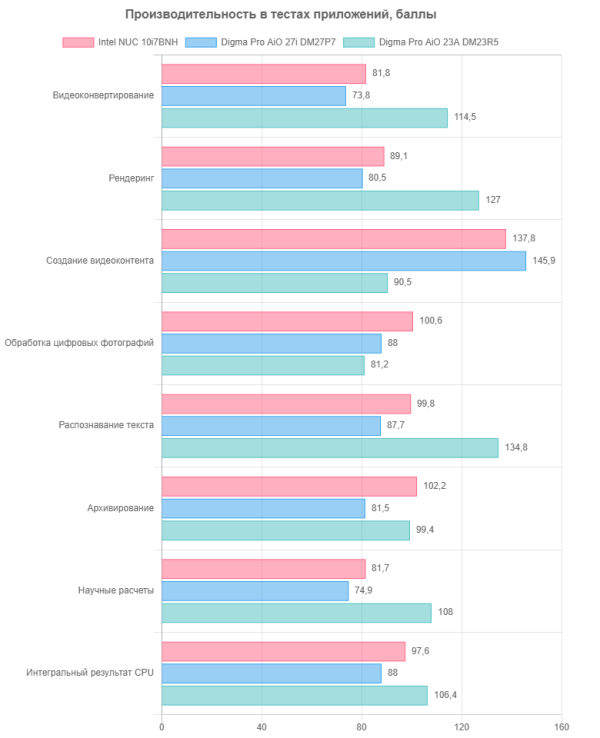
In archivers, naturally, there was a noticeable influence of one memory module with a low frequency. However, the speed of the processor part of the APU almost compensated for this disadvantage. In image processing programs such as Lightroom and Capture One, we also encountered the negative impact of slow memory. In the case of video processing programs, it was immediately clear that they work best with Intel GPUs, leaving limited support for products from other manufacturers. As a result, the overall gain was less significant than it might have been. When the processor is running unconstrained, we see up to one and a half times better performance compared to tenth generation six-core processors and/or eleventh generation quad-core processors. Thus, this platform actually represents the fastest solution of those found in the current lines of Digma Pro all-in-one PCs. In addition, the memory configuration can be easily configured yourself.
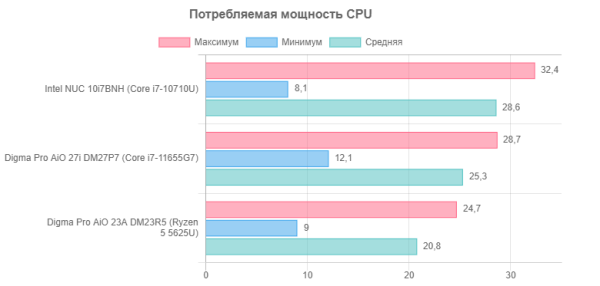
The Ryzen 5 5625U not only offers higher performance, but also better energy efficiency compared to the Core processors selected for comparison. Moreover, according to this criterion, it is ahead of even modern models with similar performance, such as the Core i5-1240P (which was recently reviewed using the Hiper ExpertBox D20 mini-PC as an example). Thus, it can be argued that this solution is not outdated and remains competitive, especially when taking into account the pricing policy. The company has made efforts to minimize costs, achieving almost direct internal competition with the tenth generation quad-core Core processors, which, in turn, have no competitors in the form of Ryzen 5. Certain compromises have been made in terms of RAM and SSD, but they, unlike processor can be easily replaced independently. At the same time, standard components have the only advantage: the ability to start working immediately after unpacking. Further steps depend on the user (or system administrator), and there are almost no restrictions in this regard. If necessary, you can install larger storage capacities, expand the amount of RAM to 32 or even 64 GB DDR4, and also replace the Wi-Fi 5 adapter with a more powerful one, since it is installed in a standard M.2 slot. The platform itself is fast enough, which facilitates such experiments.
Screen
The Digma Pro AiO 23A uses a 23.8-inch IPS panel with a resolution of 1920x1080 (confirmed by edid-decode report).
The outer surface of the matrix is black, hard and semi-matte (there is a slight specularity). There are no special anti-glare coatings or filters detected, and there is no air gap. The screen is not touchscreen. The maximum brightness is 274 cd/m² (measured in the center of the screen against a white background), which is enough for comfortable work in standard office conditions. For obvious reasons, outdoor use is not intended. When brightness is set to minimum (0%), the brightness drops to 76 cd/m². In absolute darkness, the minimum brightness may seem high to some users.
At brightness levels below the maximum, there is backlight modulation, but its high frequency (410 Hz) and small amplitude ensure that there is no flicker visible to the eye. To confirm this, graphs of brightness (on the vertical axis) versus time (on the horizontal axis) are provided for various brightness values.
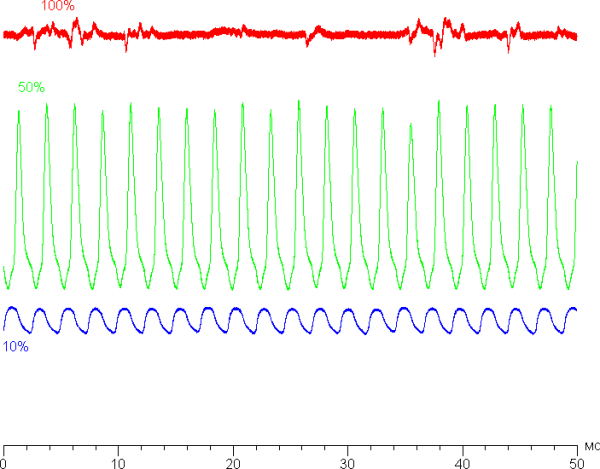
This monoblock uses an IPS matrix. Due to the matte surface in microphotographs of the screen, the subpixel structure characteristic of IPS is barely visible (black dots are dust on the camera matrix):

Focusing on the screen surface revealed randomly located surface microdefects responsible for the matte properties:

The grain of these defects is several times smaller than the size of the subpixels (the scale of these two photographs is approximately the same), so focusing on microdefects and the “jumping” of focus across subpixels when changing the viewing angle are weakly expressed, because of this there is no “crystalline” effect.
We measured brightness at 25 points on the screen, located in increments of 1/6 of the screen width and height (screen borders not included). Contrast was calculated as the ratio of the brightness of the fields at the measured points:
| Parameter | Average | Deviation from the average | |
|---|---|---|---|
| min., % | max., % | ||
| Black field brightness | 0.27 cd/m² | −9.5 | eleven |
| White field brightness | 260 cd/m² | −4.9 | 9.5 |
| Contrast | 980:1 | −12 | 9.9 |
Moving away from the edges of the screen, white uniformity is good, but black contrast, and therefore contrast, is a bit poorer. Contrast is considered typical for this type of matrix by modern standards. The screen has good viewing angles without significant color changes at large tilt angles and without hue inversion. However, with a diagonal deviation, the black field is greatly brightened and may acquire a slight red-violet tint.
Response time from black to white and back is 15ms (8ms on + 7ms off), and grayscale transitions average 23ms. The screen has a low response speed without an overclocking function.
The total output latency from switching the video buffer page to the start of display on the screen is 11 ms at a refresh rate of 60 Hz. This small delay is almost unnoticeable during everyday PC work and does not have a significant impact on fast-paced games.
We also measured the brightness of 256 shades of gray (from 0, 0, 0 to 255, 255, 255). Below is a graph showing the change in brightness between adjacent halftones (incremental values, not absolute values):
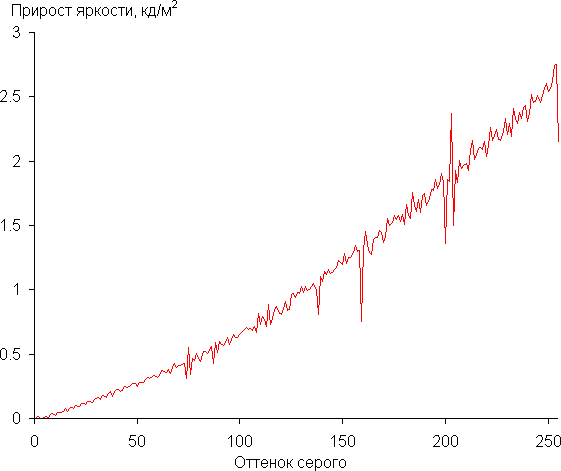
The increase in brightness on the gray scale is mostly uniform, and each subsequent shade is brighter than the previous one, with the exception of two pairs of dark shades. However, this does not spoil the overall picture.
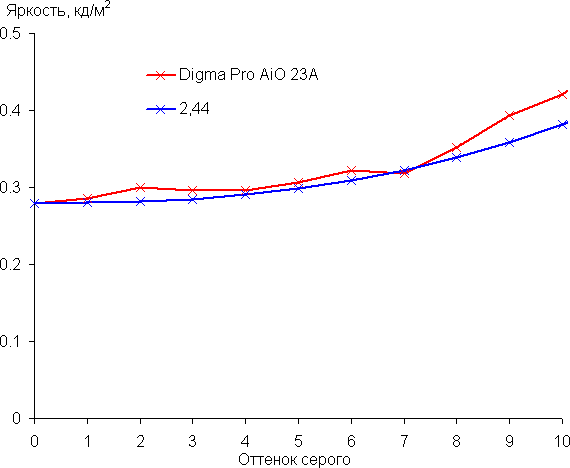
The resulting gamma curve was fitted to a value of 2.44, which is higher than the standard value of 2.2, so the image is slightly darker. In this case, the real gamma curve deviates little from the approximating power function:
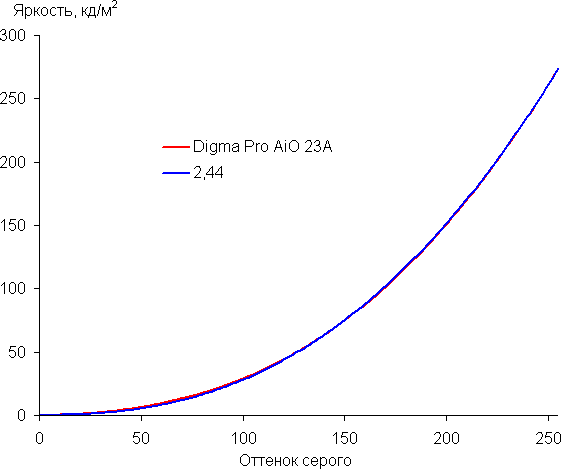
Color gamut is close to sRGB:

Therefore, visually, the colors of images oriented to output in the sRGB space have natural saturation. Below is the spectrum for the white field (white line), superimposed on the spectra of the red, green and blue fields (lines of the corresponding colors):

This spectrum with a narrow peak of blue and wide humps of green and red is typical for screens using white LED backlighting with a blue emitter and a yellow phosphor.
The balance of shades on the gray scale is high, since the color temperature slightly exceeds the standard 6500 K, and the deviation from the blackbody spectrum (ΔE) is less than 3, which is an excellent indicator even for professional devices. In addition, color temperature and ΔE practically do not change from hue to hue, which has a beneficial effect on the visual assessment of color balance. (Dark areas of the gray scale are not taken into account because color balance is less important there and color measurement uncertainty at low brightness is greater.)
To summarize, the screen of this all-in-one PC has a fairly high maximum brightness (274 cd/m²), which ensures comfortable use in typical office environments. In complete darkness, the brightness can be reduced to 76 cd/m², which may be perceived as high by some. The disadvantage is the low stability of black when the gaze deviates from perpendicular to the screen plane. Among the advantages, it is worth noting the color gamut close to sRGB and good color balance. Overall, considering typical usage scenarios, the screen quality is rated as good.
Noise level and heating
We measure the noise level in a special soundproof and semi-muffled chamber. In this case, the microphone of the sound level meter is positioned relative to the monoblock so as to simulate the typical position of the user's head: the screen is tilted back as much as possible, the axis of the microphone coincides with the normal emanating from the center of the screen, the front end of the microphone is located at a distance of 50 cm from the plane of the screen, the microphone is directed towards the screen. The load is created using the powerMax program, the screen brightness is set to maximum, the room temperature is maintained at 24 degrees, but the monoblock is not specially ventilated, so in the immediate vicinity of it the air temperature may be higher. To estimate real consumption, we also present (for some modes) consumption from the network.
| Load scenario | Noise level, dBA | Subjective assessment | Mains consumption, W |
|---|---|---|---|
| Inaction | 16.1 (background) | conditionally silent | 20 |
| Maximum CPU Load | 33.4 | clearly audible | 44 (max 74) |
If the monoblock is not loaded at all, then its cooling system under the above conditions can operate in passive mode. Even with a heavy load on the processor, the noise from the cooling system is low. The nature of the noise is quite smooth and does not cause irritation. The spectrogram confirms this: there are peaks in the mid-frequency region, but their intensity is low.
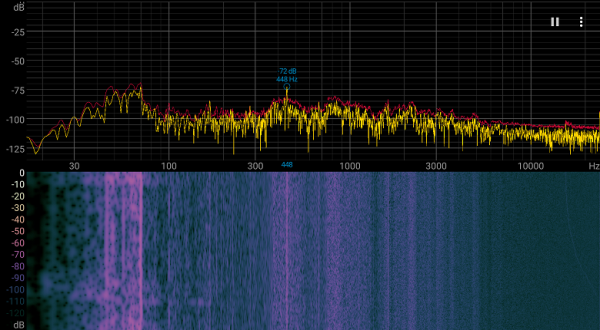
To subjectively assess the noise level, we use the following scale:
| Noise level, dBA | Subjective assessment |
|---|---|
| Less than 20 | conditionally silent |
| 20-25 | very quiet |
| 25-30 | quiet |
| 30—35 | clearly audible |
| 35—40 | noisy |
| 40—45 | very noisy |
| 45—50 | loud |
| Above 50 | very loud |
Less than 20 dBA can be considered that the computer is relatively silent. From 20 to 25 dBA it can be considered very quiet, from 25 to 30 dBA the noise of the cooling system does not stand out much from the background of ordinary office sounds. From 30 to 35 dBA the noise is already noticeable, from 35 to 40 dBA exceeds the comfortable level for long work, from 40 to 45 dBA is considered very noisy, requiring masking with background music. From 45 dBA and above the noise becomes so loud that headphones must be used. The scale is arbitrary and does not take into account the individual preferences and sensitivity of each user to sounds.
Below are thermal images taken after long-term operation of the monoblock under maximum processor load:
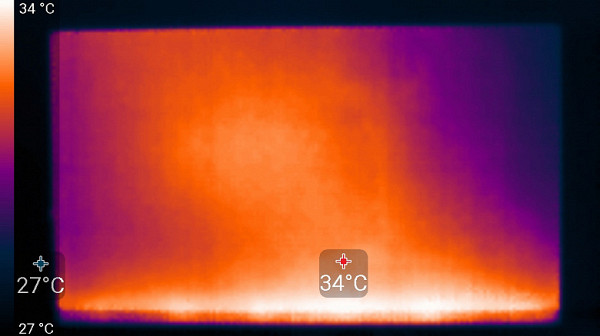
Front
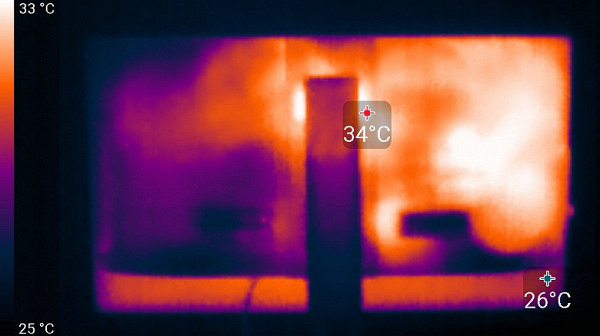
Behind
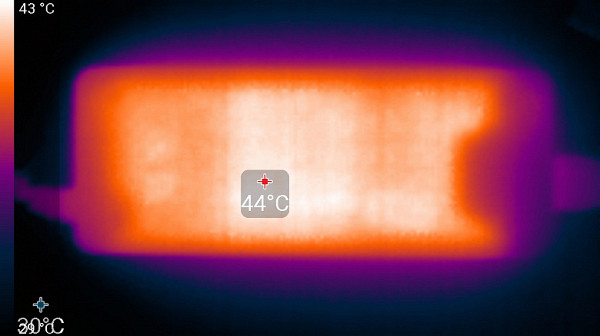
power unit
The heating of the monoblock body is moderate. The power supply does not heat up much, but it is still better to ensure that during long-term operation with high performance it is not covered with anything.
Total
The appearance of Digma Pro all-in-one PCs based on AMD processors in the range is a step in the right direction. This is especially true against the backdrop of the predominance of at most quad-core tenth-generation Core processors. The younger Ryzen 3 5425U already copes with this task, and the Ryzen 5 5625U provides even more performance. Thus, the small line of all-in-one PCs becomes more attractive, especially in the case of 27-inch models.
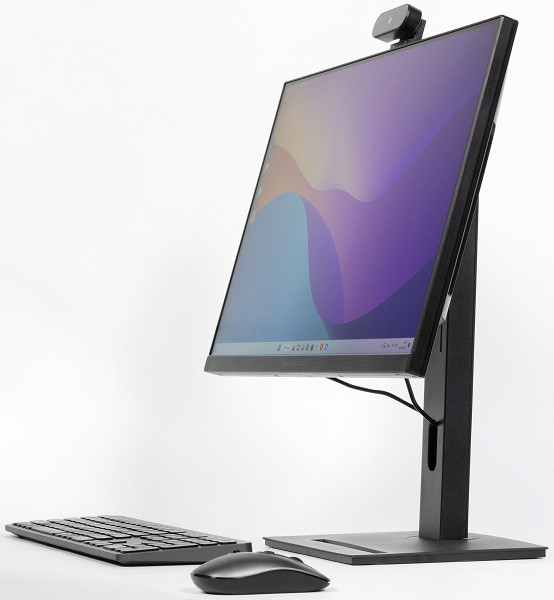
Obviously, expanding the range was not particularly difficult for the manufacturer, thanks to the standard motherboard and universal chassis. However, we do see some inconsistency between the built-in USB 3.0 ports and their usage, which could have been improved by replacing just one component. The configuration was also subject to some economic restrictions. For example, the presence of only one RAM module for a powerful processor with a GPU, as well as the use of DDR4-2666, which requires replacement or addition. Despite these shortcomings, the Digma Pro AiO 23A remains an affordable all-in-one PC based on the current AMD platform, which, despite some compromises, offers good performance at a reasonable price.



